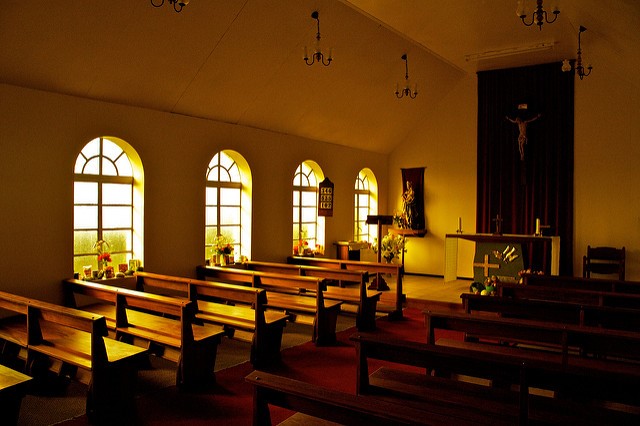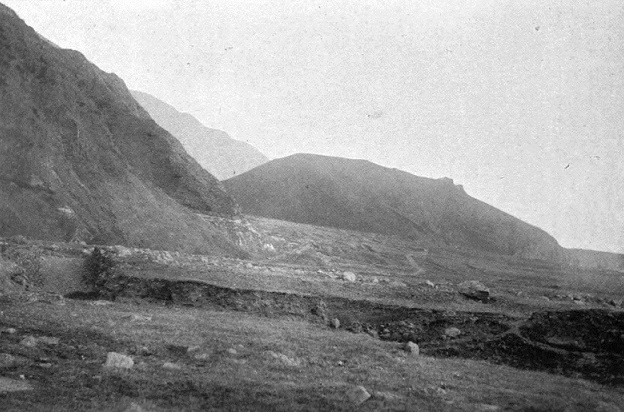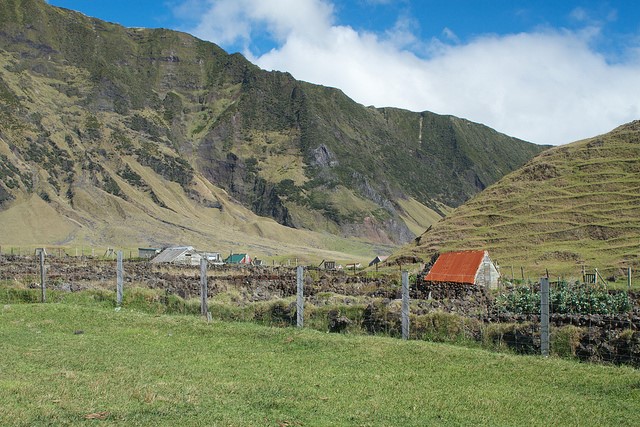On Friday April 14, 90 mm of rain (about 3 and 1/2 inches) fell on Tristan da Cunha, causing minor flooding. According to a news post on the Tristan website by the Administrator, Sean Burns, the storm cut an important roadway.

The storm evidently surprised some Tristan Islanders, who told Mr. Burns that they had never seen so much rain coming down in such a short period of time. During the Good Friday services that day, people in one of the churches could hear the rumble of rocks up on the volcano being washed down the slopes.
One of the streambeds, Big Watron, overflowed, some houses were threatened with being flooded, and the road to the west out of the Settlement that provides access to gardens in a relatively flat area a couple miles away called the “Potato Patches” was completely cut. The road slopes down and across a normally dry wash called Hottentot Gulch, which was blocked by the rocks and debris that had come down off the mountain.

Work crews were called out to help clear Big Watron, keep drains open in the Settlement, and seek to prevent houses from being flooded. Mr. Burns included in his report a couple photos of the road where it crosses Hottentot Gulch. One showed two large track hoes—what he called “diggers”— working to clear the mud, rocks, and debris from the road crossing. Two other men continued to work all day Saturday the 15th to clear the road to the Potato Patches.
Serious storms are not uncommon on Tristan. Their website has a page called “Tristan da Cunha News of Storms and the Community’s Response.” It describes, with numerous photos, a storm that battered the harbor in May 2014. On August 5th, 2015, a twister roared in from the sea and across the Potato Patches, damaging some of the huts that Islanders maintain there for their gardening needs.
Some of the storms in Tristan history have been far more serious. The Presswire service, in a report that may not be available any longer on the open web, indicated on June 5, 2001, that winds of 120 miles per hour on May 23rd had destroyed the hospital and the community center. The storm also caused major damage to many homes. Fortunately, there were no deaths nor serious injuries. A news report from the Daily Telegraph dated June 5, 2001, which also appears to no longer be available on the web, indicated that the only pub on the island was destroyed, as were a lot of cattle. News about the storm was delayed in reaching London because power on the island had been cut and radio communications were severed for days.

The most devastating storm in Tristan history occurred in late November 1885. As Munch (1971) told the story in his book Crisis in Utopia, pages 141-143, accounts of that storm and the disaster it caused varied. The basic fact was that a lifeboat with 15 men aboard, many of the adult men of the island, disappeared at sea one day. An account of the tragedy appeared in an Australian newspaper, written by a ship’s captain who told of a lifeboat pulling out of the island as if to meet his ship at sea several miles from Tristan. He wrote that the lifeboat disappeared in the waves of a serious storm: “strong squalls with a heavy sea,” the captain wrote (p.143). He indicated that he and his shipmates searched for survivors of the lifeboat for several hours before giving up and sailing away.
But accounts from the few men left alive on Tristan, and the women who were left on shore watching, varied considerably. In their accounts, the lifeboat filled with the 15 Tristan men went out carrying some trade goods to visit an unknown ship, hoping to secure some supplies, as they had done numerous times with other ships that visited. The surviving Islanders said that the weather was fair that day with moderate winds and they claimed their lifeboat met up with the unknown ship. When the ship left, it appeared to be towing the lifeboat. The 15 Tristan men never returned—kidnapped, the remaining islanders believed.
The numerous storms that have roared over Tristan since then have not been cloaked in such ambiguity—they have just tested the mettle of the Islanders.